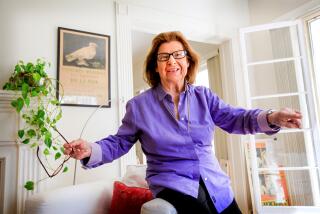Joan Hinton dies at 88; physicist joined Maoist revolution after helping develop the atom bomb
In the anti-Communist hysteria of early 1950s America, nuclear physicist Joan Hinton was labeled “The Atom Spy Who Got Away.”
Recruited at 22 to help develop the atom bomb, she was so repulsed when the U.S. dropped it on Japan during World War II that she fled in 1948 to China, where she embraced Maoism and ran a dairy farm for much of the rest of her life.
Magazines from the era presented her in caricature as a trenchcoated femme fatale engaged in nuclear espionage, a charge she always denied. Hinton chortled when she told The Times in 1999 that reality was far more mundane: the science she practiced in China was aimed at finding the best way to breed horses and milk cows.
Hinton died June 8 at a hospital in Beijing, said a spokeswoman for the Chinese Academy of Agricultural Mechanization, which Hinton had worked with since 1979. She was 88.
“I don’t want to spend my life figuring out how to kill people,” Hinton said in 2002 on National Public Radio as she explained her disgust with nuclear warfare and her attraction to China. “I want to figure out how to let people have a better life, not a worse life.”
Born in Chicago in 1921, she was a graduate student at the University of Wisconsin with a reputation as a daring snow skier when she was asked to join the Manhattan Project, which would produce the atom bomb.
A talent for equations ran in the family. She was the great-granddaughter of George Boole, the 19th century inventor of Boolean algebra, and a cousin of G.I. Taylor, an English physicist who was one of the great scientists of the 20th century.
After arriving in early 1944 at the research site at Los Alamos, N.M., Hinton assisted Enrico Fermi, a chief scientist on the project. She was part of a group that built two reactors for testing enriched uranium and plutonium.
When the first atomic bomb was detonated on July 16, 1945, in the New Mexico desert, Hinton was banned from the test area but sneaked in on the back of a colleague’s motorcycle to watch the dawn blast.
“We first felt the heat on our faces, then we saw what looked like a sea of light,” she told the South China Morning Post in 2008. “It was gradually sucked into an awful purple glow that went up and up into a mushroom cloud. It looked beautiful as it lit up the morning sun.”
The next month, she learned that the bomb had been used to destroy two Japanese cities. Horrified, she became a peace activist.
Influenced by her brother, William Hinton, a Marxist writer who documented Chinese village life, she moved to China as its revolutionary fervor was attracting left-leaning Americans.
She was the daughter of lawyer Sebastian Hinton, who patented the jungle gym, and his wife, Carmelita, founder of Vermont’s progressive Putney School, which Joan Hinton attended. She had started the decade earning her bachelor’s degree in natural science from Bennington College in Vermont and ended it by getting married in the mountains of China.
Her husband was Erwin “Sid” Engst, a fellow expatriate who grew up on a farm in New York. He had moved to China in 1946 to start a dairy program with the help of the United Nations.
For 18 years, they lived in rural Shaanxi province, where they raised cattle, ducks and three children who grew up speaking only Chinese. They learned English as adults and at one point all lived in the U.S. Her two sons, Bill and Fred, and a daughter, Karen, survive her.
Since the early 1980s, Hinton had lived and worked on a state-owned dairy farm outside of Beijing. Her husband bred the cows and she designed the milking equipment and agricultural machinery. After he died in 2003, Hinton stayed on the farm.
Throughout her life, she remained a Maoist, committed to the proletarian ideals of Communist revolutionary Mao Tse-tung. She called the Mao years “terrific” even when interviewers pointed out that many Westerners and Chinese had come to believe that Mao’s policies were misguided and had caused many deaths by famine and violence.
“Mao started the Cultural Revolution to cure the disparity between the few and the many,” Hinton said in 1996 in the New York Times. “How could that be wrong?”
As capitalist reforms eroded the “socialist utopia” that she had toiled for, Hinton never wavered in believing that her life’s journey had been worthwhile.
“I think it’s extraordinary,” she said in the 2002 NPR interview. “I’ve taken part in two of the greatest things of the 20th century — the development of the atom bomb and the Chinese Revolution. Who could ask for anything more than that?”
More to Read
Start your day right
Sign up for Essential California for the L.A. Times biggest news, features and recommendations in your inbox six days a week.
You may occasionally receive promotional content from the Los Angeles Times.







